Introduction:
Pilling and other changes in surface appearance, such as fuzzing, that occur in normal wear are simulated on a laboratory testing machine. Pills are caused to form on fabric by a random rubbing action produced by tumbling specimens in a cylindrical test chamber lined with a mildly abrasive material. To form pills with appearance and structure that resemble those produced in actual wear, small amounts of short-length gray cotton fiber are added to each test chamber with the specimens. The degree of fabric pilling is evaluated by comparison of the tested specimens with visual standards that may be actual fabrics, or photographs of fabrics, showing a range of pilling resistance. The observed resistance to pilling is reported using an arbitrary rating scale.
SBT512 Random Tumble Pilling Test Machine is specially designed equipment to determine the pilling and fuzzing characteristics of textile fabrics.
Technicial details:
| Number of Chambers | 4 Nos. |
| Size of chamber | 146mm (inside diameter) x 152mm (length) |
| Length of impeller | 121mm |
| Number of samples | 12 (3 in each compartment) |
| Impeller rotation speed | 1200 ± 10 rpm |
| Timer | up to 99 min and 59 s |
| Compressed air injection | 14kPa - 21kPa (2 - 3 Psi) |
| Cork sheet | 1.5mm (H) x 148mm (W) x 452mm (L) |
| Chloroprene sheet (optional) | 3mm (H) x 452mm (L), 47±3° (in hardness) |
| Dimensions | 700 x 400 x 550 mm |
| Power supply | 220V, 50Hz or 110V, 60Hz |
| Weight | 80kg |
Usage:
To determine the pilling and fuzzing characteristics of textile fabrics.
Testing standards:
ASTM D3512 Standard Test Method for Pilling Resistance and Other Related Surface Changes of Textile Fabrics: Random Tumble Pilling Tester
ISO 12945-3 Textiles- Determination of the fabric propensity to surface pilling, fuzzing or matting
Part 3: Random tumble pilling method
JIS L 1076 Testing methods for pilling of woven fabrics and knitted fabrics
DIN 53867 Testing of textile fabrics; determination of pilling with the Random-Tumble-Pilling-Tester.
Test procedure :
Sample Preparation:
1. Cut a 4.13" square on the bias at approximately a 45° angle to the warp and filling directions.
2. Condition sample and cork liners by bone drying and then bring them to moisture equilibrium in the controlled chamber.
Loading the Random Tumble Pilling Tester:
1. Place Specimen and a 25 mg of a 5 mm (0.2") gray colored cotton fiber into the test chamber.
2. Place the cover on the chamber and set the timer for a running time of 30 minutes.
(10 minute intervals for up to 30 minutes may be more indicative for certain knits or soft-woven fabrics.)
3.Turn the motor switch to "on" and push the "start" button, and start the airflow.
4. During the run check each chamber at frequent intervals.
(If the specimen becomes wedged around the impeller without tumbling or lies on the bottom or side of the chamber, shut off the air, stop the machine, remove the face plate, and free the specimen. Record on a data sheet any abnormal behavior or hang ups of the specimen.)
5. After each run, rake out each specimen and clean off excess cotton fiber using the vacuum cleaner.
Preparation for Evaluation:
Place each specimen on the double faced tape in the viewing cabinet.
Salient Features:
1. Vertical instrument with 2 or 4 chambers.
2. Compact, rigid construction, with small footprint.
3. Simple-to-use control system.
4. Chambers illuminated, utilising long-life LED technology.
5. Interlocked chamber doors for maximum operator safety.
6. Adjustable air pressure.
7. Audible alarm signals end of test.
8. Equipped as standard with an American (ASTM D 3512) impeller - other impellers to special order.










